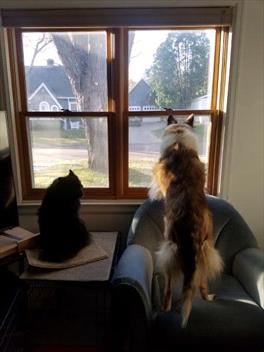Two dogs looking out front window

Zita and Sierra staring out the window, wondering where their Mom was. Photo by Phyllis DeGioia/VIN.
Being neurotic about pet care instructions is my best way to ward off anything bad happening while I'm out of town.
Well, it works for me.
I tend to leave overly explicit instructions for the dog sitter; this time, it was Emily and it was her first time dog sitting for me. Notice I did not say house sitter. I don't care as much about the house, although I'm sure I would if it burned in a fire (photos, jewelry, ID tags from deceased pets, that sort of thing), but even with a fire, my first thoughts would center around whether or not my pets are safe.
You might think that this overkill is simply an occupational hazard of working closely with veterinarians, who more often than not are as "detail oriented" as can be, but I did it well before I started writing about pets for a living. Perhaps, on contemplation, my occupation is basically a hazard of how neurotic I am about my pets.
What information do I leave? First, the basics - all pertinent contact numbers, including my vet and the veterinary ER I like best, where I'll be and specific dates. Years ago, I would leave hotel dates and phone numbers, but with cell phones there's no need for that, and this past trip I stayed with friends with no land lines rather than hotels. I make a big deal out of a clear layout and ease of reading. The format issue has loomed larger over the past few years, and it must now be outlined in a table or spreadsheet, depending on the level of complexity in the instructions. If I don't see it clearly, neither will the dog sitter.
This past vacation is the first time I have left these two particular dogs together. Sierra just joined our family in the middle of the pandemic, and when we rented a lakeside cabin last year, the dogs came with us.
After listing contact numbers and date I will return, including neighbors who have my house keys, medication is the most important information.
Both of my dogs take the same medication for spay incontinence, but at wildly differing doses, so it's confusing. (In my head: Confusion = lack of clarity = med mistake.) Incurin comes in blister packs of 30, and they each have their own pack. Zita takes only half a pill two days a week (Monday and Friday), and Sierra takes a whole pill every day.
Sierra also takes meds for her nasty allergies. She is prone to staph skin infections on her belly, and sure enough when I recently left for vacation, she was in the middle of yet another 2-week course of antibiotics that comes in capsules. Her staph signs can be pretty subtle, and I don't have to wait until her belly is red and blotchy for my vet to give her meds; my own allergies show up as nasal congestion, so I can never smell an infection.
Once Sierra finished her course of antibiotic capsules, she was supposed to go back to taking 1.5 antihistamine tablets every morning, and again in the evening if she appears particularly itchy. She doesn't need them when she has antibiotics on board killing all the stuff that makes her scratch. Despite everything, did I get around to writing about her need for post-antibiotic antihistamines? No, I did not. I don't want to believe that, but it's true. Despite licking her front paws a bit, when I got home she seemed okay and not in the throes of an international allergy incident.
So much for my occupational hazard neuroses, right?
Nonetheless, it all worked liked magic, if not clockwork. All the dog sitter said was that Sierra was reluctant to eat - that is Sierra's first response to stress or changes - so Emily added tuna juice. Sierra reluctantly began to eat but afterwards would not eat unless there were tuna particles in her food.
"She's yanking your chain," I texted to Emily from Italy.
"I know," Emily responded. "But I don't mind."
But it all worked out, and unlike the time I had to put my stress-prone cat Dickens into a kennel because the hardwood floors were being refinished, no one had to go to the veterinarian for tranquilizers and fluids. Plus, I don't go into the level of overkill that my friend, a former professor of large animal medicine at the veterinary school, does: she outlines the number and size of biscuits her dog gets when going into the crate vs. the number she gets coming in from the back yard.
To recap, no dog escaped, no dog got sick, no dog got hit by a car, no dog threw up blood, no dog had diarrhea, no dog swallowed socks, no dog choked, no dog ingested anything toxic, no dog organs ruptured, no dog appeared anywhere near death's door step, and despite my getting stuck with an overnight layover on the way home, nothing untoward happened in 17 days that did not involve tuna particles. Add in espresso the way it is supposed to be enjoyed, with a ceramic saucer and cup and spoon and a bit of sugar, none of this nonsense with a paper cup while driving around, and I call that a good vacation.
It was also another win for the neurotic set. Please, come and join us. It's the safest approach this side of crossing your fingers.
1 Comment
Catherine A Schulz
August 19, 2022